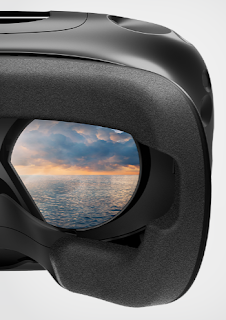HTC is one of the leading manufacturer of VR headsets and other devices
 |
| HTC Vive VR head set |
- HTC VIVE
- How it works
- Unique features included in HTC VIVE VR headset
- HTC VIVE for gaming
- SteamVR™ Tracking technology
- Where to buy and best deals for HTC VIVE
- System requirements for HTC VIVE VR
HTC VIVE:The Ultimate VR effect
HTC Vive is room scale virtual reality head-mounted display launched by HTC which provides fully immersive Virtual Reality effect.Vive is brought to you by HTC and Valve. Uniting passion, talent, and innovation, Vive delivers on the promise of VR with best-in-class technology and content.
How HTC VIVE Works
This headset is designed to utilize "room scale" technology to turn a room into 3D space via sensors, with the virtual world allowing the user to navigate naturally, with the ability to walk around and use motion tracked handheld controllers to vividly manipulate objects, interact with precision, communicate and experience immersive environments.
Awards won by HTC Vive
Unveiled during HTC's Mobile World Congress keynote in March 2015, the HTC Vive has since been awarded over 22 awards in CES 2016, including best of CES.
Best of CES 2016,Best Entertainment- Slash Gear
Unique features included in HTC Vive
Front facing camera blends real world elements into the virtual world
110 degree field of view
32 headset sensors for motion tracking
2160*1200 combined resolution and 90 Hz refresh rate deliver eye popping graphics and smooth action
HTC Vive for gamers
HD haptic feedback and intuitive gestures mean playing games and interacting with the virtual world comes naturally. Vive’s two wireless controllers feature 24 sensors for unobstructed movement, meaning you can do more in VR than ever before.
Haptic or kinesthetic communication recreates the sense of touch by applying forces, vibrations, or motions to the user.This mechanical stimulation can be used to assist in the creation of virtual objects in a computer simulation, to control such virtual objects, and to enhance the remote control of machines and devices. Haptic devices may incorporate tactile sensors that measure forces exerted by the user on the interface.
Intuitive gesture:gesture sensing through intuition rather than from reasoning or observation
Multifunctional track pad provides effortless precision and HD haptic feed back.Dual stage triggers with HD haptic feed back brings VR experience to a new level.Two handheld controllers each have 24 sensors for accurate tracking.
 |
| htc handheld controller |
 |
| trackpad |
 |
| Sensors on handheld device |
SteamVR™ Tracking technology
 |
| SteamVR™ Tracking technology |
Breakthrough SteamVR™ Tracking technology lets the headset and controllers know in real time where they are within a room. Freely explore and interact with objects, characters and environments. Room-scale VR puts you at the center of everything.
two base station provides 360 degree motion tracking for superior VR experience
how SteamVR™ Tracking technology works
The tracking system gives you your own personal GPS right in your living room,accurate to a millimeter.Beacause LASERS roomscale VR gives you the freedom to move around and to gain an entirely new perspective on in-game world.If you get too close to the real world while in the virtual one ,the chaperone will give you a gentle(Virtual) reminder.
Vive port
Viveport is a place where people can discover the latest and greatest in VR content and experiences.interactive Videos, games and much more
Vive provides you with a handful of VR contents at vive port.
What you need for experiencing fully immersed VR using HTC Vive
How to buy HTC Vive VR head set
You can purchase HTC Vive directly from vive store or from leading online stores amazon and ebay.
It is also available at microsoft store
HTC Vive best buy
HTC Vive VR set is priced between $839.99 $600 and $800.
Price of HTC Vive at various online shopping karts :- eBay-$839.99 (new)
- eBay-$650 (used)
- amazon-$799.99
- microsoftstore- $799.99
- Vive store-$799.99
HTC vive system requirements
Recommended computer spec for installing vive
- Processor: Intel™ Core™ i5-4590 or AMD FX™ 8350, equivalent or better
- Graphics: NVIDIA GeForce™ GTX 1060 or AMD Radeon™ RX 480, equivalent or better. For additional graphics card options, view the complete list.
- Memory: 4 GB RAM or more
- Video output: 1x HDMI 1.4 port, or DisplayPort 1.2 or newer
- USB: 1x USB 2.0 port or newer
- Operating system: Windows™ 7 SP1, Windows™ 8.1 or later or Windows™ 10
You can also check your PC using a small exe file provided in htc vive site.












